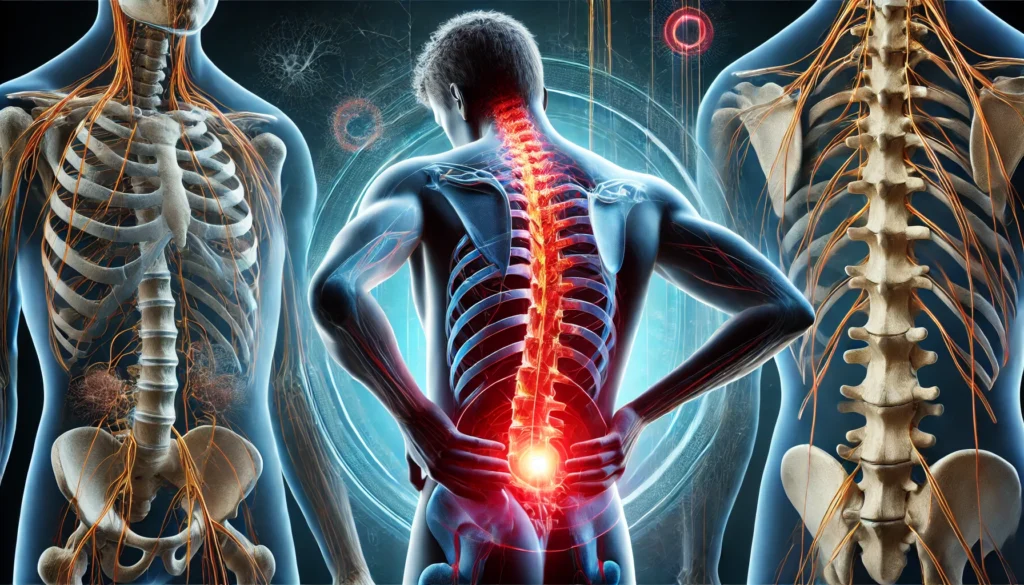Vertebrogenic low back pain refers to pain originating from the spine, specifically the vertebrae, discs, or surrounding structures. It’s one of the most common forms of chronic back pain, affecting millions of people worldwide. This type of pain can be debilitating and significantly impact daily activities. Understanding its causes, symptoms, treatment options, and ways to prevent it can help individuals manage and reduce its effects. In this article, we will dive into vertebrogenic low back pain, providing a comprehensive guide to its management.
What is Vertebrogenic Low Back Pain?
Vertebrogenic low back pain arises from problems within the spine. The spine consists of vertebrae, intervertebral discs, muscles, ligaments, and nerves. If any of these structures become damaged or diseased, it can lead to vertebrogenic pain. The pain is often localized in the lower back but may radiate to the legs in some cases, making mobility and daily functioning more difficult.
Read Also: Dorsalgia Definition: Understanding the Causes, – Definition of Dorsalgia!
Common Causes of Vertebrogenic Low Back Pain
Several conditions can lead to vertebrogenic low back pain, including:
Degenerative Disc Disorder
Degenerative disc disease may lead to the thinning of these discs, resulting in pain when moving or standing for extended periods.
Bulging Discs
This can irritate surrounding nerves and lead to localized pain or radiating pain down the legs (sciatica).
Spinal Canal Narrowing
Spinal stenosis involves the narrowing of the spinal canal, which can put pressure on the spinal cord and nerves. This condition is often age-related and may cause pain, numbness, or weakness in the lower back and legs.
Facet Joint Dysfunction
The facet joints in the spine provide stability and allow movement. When these joints become inflamed or arthritic, they can cause vertebrogenic pain in the lower back. This condition is common in older adults.
Vertebral Slippage
Spondylolisthesis occurs when one vertebra slips over another, potentially pinching nerves and causing pain. It can result from a degenerative condition or an injury.
Osteoarthritis of the Spine
Osteoarthritis, a type of joint inflammation, can also affect the spine. When the cartilage between the vertebrae deteriorates, it can lead to pain, stiffness, and inflammation in the lower back.
Symptoms of Vertebrogenic Low Back Pain

The symptoms of vertebrogenic low back pain can vary depending on the underlying cause but generally include:
- Persistent pain in the lower back, which may worsen with movement or prolonged standing
- Radiating pain down one or both legs, especially if nerves are compressed (sciatica)
- Stiffness in the back that limits range of motion
- Numbness or tingling in the legs or feet
- Pain that worsens when sitting, bending, or lifting objects
- Muscle weakness or difficulty walking, in more severe cases
If these symptoms persist or worsen, it’s essential to consult a healthcare provider for diagnosis and treatment.
How to Treat Vertebrogenic Low Back Pain
Treatment for vertebrogenic low back pain depends on the severity and the underlying condition. Common treatment options include:
1. Rest and Activity Modification
In the case of acute pain, rest and avoiding activities that exacerbate the pain can help reduce inflammation and provide relief. However, prolonged bed rest is usually not recommended, as it may lead to muscle stiffness and weakness.
2. Physical Therapy
Physical therapy is one of the most effective treatments for vertebrogenic low back pain. A physical therapist can help develop a personalized exercise plan that strengthens the muscles around the spine, improves flexibility, and promotes better posture. This can reduce pressure on the spine and alleviate pain.
3. Pain Relief Medications
For more severe pain, a doctor may prescribe stronger medications, including muscle relaxants, opioid medications (for short-term use), or topical treatments.
4. Corticosteroid Injections
For more intense or persistent pain, corticosteroid injections may be used. These injections administer anti-inflammatory medication directly to the targeted area, offering temporary relief from pain and swelling.
5. Chiropractic Care
Chiropractic adjustments can help align the spine and improve mobility, potentially reducing vertebrogenic pain.
6. Surgical Intervention
In severe cases, surgery may be necessary to address the underlying cause of vertebrogenic pain. Surgical options include disc replacement, spinal fusion, or decompression surgery, depending on the specific condition and severity.
Prevention of Vertebrogenic Low Back Pain
While it may not be possible to prevent vertebrogenic low back pain entirely, there are steps you can take to reduce your risk:
1. Maintain a Healthy Weight
Excess weight puts added pressure on your spine and discs, increasing the risk of pain. Maintaining a healthy weight through a balanced diet and regular exercise can help reduce strain on the lower back.
2. Exercise Regularly
Engaging in regular physical activity strengthens the muscles that support the spine. Low-impact exercises, such as swimming, walking, and yoga, are particularly beneficial for back health.
3. Practice Proper Posture
Maintaining good posture while sitting, standing, and lifting can reduce strain on the spine. Make sure your workstation is ergonomically set up, and avoid slouching or hunching over.
4. Stretch and Strengthen Your Back Muscles
Incorporating flexibility exercises and strength training into your fitness routine can help keep your spine healthy and reduce your knees and keep your back straight. Avoid twisting motions while lifting the risk of injuries. Focus on exercises that target your core, as a strong core helps stabilize the spine.
5. Use Proper Lifting Techniques
When lifting heavy objects, always beg, and use your legs to do the heavy lifting.
When to See a Doctor
If your vertebrogenic low back pain is persistent, severe, or accompanied by symptoms like numbness, tingling, or weakness in the legs, it’s important to seek medical attention. A doctor can diagnose the underlying cause and recommend the appropriate treatment plan.
FAQs:
1 What causes vertebrogenic low back pain?
Vertebrogenic low back pain is caused by conditions like degenerative disc disease, herniated discs, spinal stenosis, or facet joint dysfunction.
2 How is vertebrogenic low back pain treated?
Treatment includes rest, physical therapy, pain medications, corticosteroid injections, and in severe cases, surgery.
3 Can physical therapy help with vertebrogenic low back pain?
Yes, physical therapy can strengthen muscles, improve flexibility, and relieve pain, helping to manage vertebrogenic low back pain.
4 What are the symptoms of vertebrogenic low back pain?
Symptoms include persistent lower back pain, radiating pain down the legs, stiffness, numbness, and weakness.
5 How can I prevent vertebrogenic low back pain?
Maintaining a healthy weight, exercising regularly, practicing good posture, and using proper lifting techniques can help prevent vertebrogenic low back pain.
Conclusion:
Vertebrogenic low back pain is a common and often debilitating condition caused by issues within the spine. Understanding the causes, recognizing the symptoms, and exploring treatment options can help manage the pain and improve quality of life. With the right approach—ranging from physical therapy to lifestyle changes and, in some cases, surgical intervention—you can reduce the impact of vertebrogenic low back pain and live an active, pain-free life.











